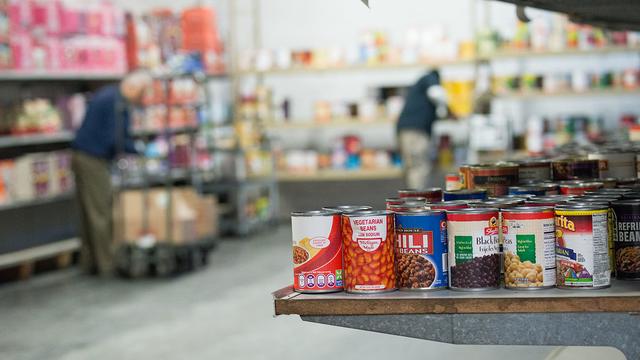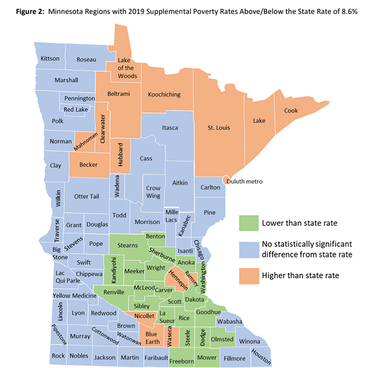The Humphrey School of Public Affairs in collaboration with the Minnesota Community Action Partnership (MinnCAP) has released a new report on poverty in Minnesota that highlights persistent income disparities based on racial/ethnic background, age, and geography.
For many Minnesotans, particularly African American and Native American households, their incomes and federal benefits programs are not enough to cover the costs of meeting their basic needs.
The report, authored by Humphrey School economist Angie Fertig, finds that in 2019, Minnesota’s supplemental poverty rate was 8.6 percent, significantly lower than the national average of 14.2 percent.
(Fertig based her analysis on the supplemental poverty measure, because “it’s considered a superior method of estimating economic deprivation compared to the 'official poverty measure' produced by the Census Bureau. It accounts for more public assistance benefits like SNAP and the earned income tax credit, and adjusts for geographic differences in housing costs.")
The research
Minnesota’s 8.6 percent poverty rate is better than the national rate due to Minnesota’s higher median income, higher minimum wage, and more generous ‘safety net’ programs, Fertig says. But, she adds, low-income Minnesotans still struggle with the high cost of housing, child care, and state and local taxes.
The relatively low statewide rate also masks a wide variation in poverty rates for older residents, geographic areas of Minnesota, and racial and ethnic groups.
In terms of geographic differences, the poverty rate ranges from a high of 13.7 percent in the northwest central region of the state, to a low of 3.8 percent in Washington County in the eastern Twin Cities metropolitan area.
Three regions encompassing 13 rural counties have rates above 10 percent, as do Ramsey and Hennepin counties in the Twin Cities metro, and the Duluth metro area.
The poverty rate for Minnesotans aged 65 and older is higher than the statewide average, at 10.2 percent.
The disparities among racial/ethnic groups are particularly stark, Fertig says, with poverty rates for African American and Native American residents at least three times higher than for white Minnesotans.
Poverty rates in Minnesota by race/ethnicity:
- White: 7.0 percent
- Asian: 10.6 percent
- Hispanic: 11.2 percent
- African American: 20.7 percent
- Native American: 28.5 percent
- Multiracial/other race: 10.5 percent
MinnCAP, which commissioned the report, represents the 24 Community Action Agencies (CAAs) in Minnesota whose mission is to remove obstacles and solve problems that block the achievement of self-sufficiency.
To reduce poverty across the state, CAAs work to better focus available local, state, private and federal resources to assist individuals and families with low incomes to acquire useful skills and knowledge, gain access to new opportunities, and achieve economic self-sufficiency.
In addition, MinnCAP advocates at the state and federal levels for policies that help build community resiliency, address the causes of poverty, and enhance financial stability.
The call to action
Federal and state benefits programs help offset many of the costs incurred by people with low incomes in terms of food, rent, medical bills, and other necessities. Bill Grant, MinnCAP executive director, says the new report makes clear that these basic living costs are too high to be offset by available programs—especially for BIPOC (Black, Indigenous, and people of color) households.
To ensure that more people are able to rise out of poverty, MinnCAP is calling on lawmakers and policy makers to implement three statewide policy initiatives:
- Increase the eligibility threshold for the Supplemental Nutrition Assistance Program (SNAP, formerly called food stamps) to 200 percent of the Federal Poverty Level, from the current level of 165 percent.
- Invest immediately to address the affordable housing crisis throughout Minnesota by taking advantage of the historic state budget surplus.
- Create a new Poverty Commission, through Gov. Tim Walz’s executive authority, to end poverty in Minnesota by the end of this decade, with a focus on BIPOC income disparities highlighted in this report.
“MinnCAP’s recommended policy initiatives will help build community resilience, address the causes of poverty, and enhance financial stability,” says Grant. “Where federal assistance programs fall short, Minnesota needs to invest in its people to help lift them out of poverty.”
Grant notes a similar effort was launched in 2009, when the Commission to End Poverty in Minnesota by 2020 issued a suite of recommendations but saw very little follow-up action.
“This report highlights the continuing crisis of poverty, with far too many families struggling to pay for food, housing and other necessities,” says State Sen. John Marty, DFL-Roseville, who co-chaired the 2009 commission. “It is tragic to see the lack of action [since then] to implement the recommendations. In appointing the new commission recommended in this report, the governor must insist on bold action that will actually achieve the goal of ending poverty for all Minnesotans.”
With recent news of Minnesota’s $9.2 billion budget surplus, now is the time to take the findings from this poverty report and put them into action, Grant says.
“We need to invest in efforts to increase housing affordability and the programs that lift Minnesota families out of poverty," he says. "We implore Minnesota lawmakers and policymakers to take action now to invest in our citizens struggling every day to live in dignity and respect.”
About MinnCAP
Minnesota Community Action Partnership is made up of 24 Community Action Agencies and 11 Tribal Nations. It serves all 87 counties across the state, providing poverty solutions through various programs and services including: homeless prevention and housing assistance, utility bill assistance, healthcare enrollment, food and nutrition services, Head Start early childhood programming, financial asset building, regional transit, and more. MinnCAP advocates at the state and federal levels for policies that help build community resiliency, address the causes of poverty, and enhance financial stability.



